
Near Earth Asteroids
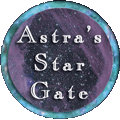


What a long way we've come from the celestial police of the Victorian Era, to the discovery of over 10,000 NEAs at the beginning of 2014. Although there are many NEAs, some are more interesting than others. It takes more than the discovery moment to understand our distant neighbors. What is this new discovery? Is it a Near Earth Asteroids? A Potentially Hazardous Object? Is it in the Main Belt? Is it a Friend or Foe? Astra's Asteroid Catalog looks at some of the more interesting or promising NEAs.
Interesting Asteroids
Some asteroids have been observed more often then others. The really faint ones, like the 28- magnitude asteroid that the asteroid redirect mission is seeking to ensure Earth's safety, are often spotted. Once found, they are soon lost, but will they be seen again? Will they find their way to the bottom of the sea or burn up in the sun? How do we visualize the paths that these asteroids take and how will we influence those paths in the future?
An NEA is considered a Potentially Hazardous Asteroid (PHA) when its orbit comes within 0.05 AU (7.5 million km) of the Earth's orbit. This is referred to as the Earth Minimum Orbit Intersection Distance (MOID)The largest known PHA is 4179 Toutatis (1989 AC), 9 km in diameter.
The future of space exploration will depend on finding asteroids with the right qualities to be used as resources. When the NEA pages originated, this meant seeking the right NEA for ARM

Link to the Asteroid Redirect Mission
One of the scariest asteroids of all time, Apophis was discovered on June 19, 2004 by astronomers at Kitt Peak Observatory. Apophis is an Aten asteroid that orbits the sun every 323.5 days. It has been officially observed over 4,000 times and in April 2013, the Arecibo radio telescope took additional measurements to rule out the possibility of a strike by Apophis in 2029.
Because Apophis is so close and so large, there is an Apophis page on the NEA site at Astras!
The Plymouth Rock mission was proposed in 2009 by Lockheed Martin under the Constellation program back when NASA was following the Vision for Space Exploration. The concept required a "deep space" version of the Orion spacecraft capable of travelling over 10 million kilometers to a distant asteroid. At that time the newly discovered asteroid 2008 EA9 was proposed as a likely target.
The asteroid 2008 EA9 was hopefully dubbed, "Plymouth Rock", befitting a destination at a distant new world. Lockheed Martin put a lot of work into the design of the mission without outside financial support and it really is their mission. This mission was widely discussed and provides a very realistic look into the logistics and challenges of a human mission to the asteroids.
Lockheed Martin's Plymouth Rock mission - Presented at the SBAG meeting in November 2009.
This document contains a lot of interesting information and details on a human mission to the asteroids. Well worth examining because of the logistical information on a deep space mission to the rocks . . . er, stars.
On the morning of October 6, 2008, a small asteroid was discovered by the Catalina Sky Survey. The preliminary calculation of the orbit of this asteroid showed that it was heading straight for planet Earth and that impact was eminent. Within an hour of the asteroid's discovery, JPL determined that the and found to be an impactor. It landed the Sudan less than 21 hours after its discovery on that October morning.
The full story of Earth-impacting asteroid 2008 TC3
The discovery and prediction of an NEA impact tested the process and demonstrated the effectiveness of NASA's Near-Earth Object Program. After the discovery of 2008 TC3, 26 international observatories provided observational information that confirmed the orbit and impact. The impactor was estimated to be
Asteroid 2008 TC3 Strikes Earth: Predictions and Observations Agree - NASA's NEO program write up
On September 15 2007, a chondritic meteorite crashed near the village of Carancas, Peru, just before noon (16:40 UT), local time. Carancus is in southern Peru, near the Bolivian border. The impact left a crater about 43 ft. wide. The impactor is believed to be 2m in diameter and was fragmented when it hit the ground.
The meteorite was seen by local residents. The impact itself was observed by a local resident. There were no human injuries but a llama was killed by the impact and minor damage to local buildings was reported. Local residents who visited the site became ill shortly after, with symptoms like nausea, headaches, diarrhea and vomiting. Studies determined that the illness may have been caused by gasses released by the impact.
3753 Cruithne orbits in a bean-shaped orbit as viewed from the Earth. Its orbit describes a horseshoe that can transition into a quasi-satellite orbit.[t has been incorrectly called "Earth's second moon" but it does not orbit Earth.
Near-Earth Asteroid 2012 DA14 to Miss Earth on February 15, 2020
The world was awaiting a NEA close approach side show, but no. There was new kid in town! Asteroid 2012 DA14 & Chelyabinsk Impactor
Is it an asteroid or a piece of space junk, like a Saturn rocket?
This asteroid, or rather NEO was discovered in November 1991 by Jim Scotti using a Spacewatch telescope at Kitt Peak observatory. Shortly after discovery, it was seen to change brightness and it was thought that this might be a piece of early space hardware. Some even speculate that it is some kind of alien probe. In any case, it is very small, perhaps a mere 30-feet in diameter, making it difficult to observe. The next close passage is October 26, 2016 when Earth catches up with this elusive object.
Is this an NEA that we can capture and examine closely, or just some piece of space junk launched in an earlier epoch of human space flight?
1991 VH
Binary asteroid
1991 VH was discovered on November 9, 1991, by Robert McNaught at Siding Spring Observatory in New South Wales, Australia. This rather erratic NEA was imaged by Arecibo Observatory in 2008. It is a binary system composed of a roundish primary body less than a mile in diameter, in fact about 1 km in diameter. The natural satellite is smaller. The 1991 VH system is unusual because the satellite does not have a synchronous rotation but rather tumbles around its primary in an eccentric orbit. This asteroid system was one of two targets for NASA's Janus Mayhem mission, that is unfortunately delayed and discussed further in the next section.
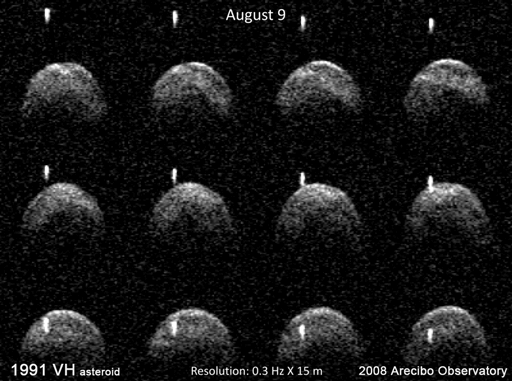
Doppler radar imaging of asteroids should soon be discussed at Astra's Stargate. This is an important observing technique that has helped us to understand how far away asteroids are and how they interact with their companions. Unfortunately due to the demise of Arecibo, we have to rely on smaller radio telescopes, including NASA's busy Goldstone antenna.
1996 FG3 (175706) is an near Earth asteroid that was discovered on March 24, 1996, by Robert McNaught at Siding Spring Observatory in New South Wales, Australia. 1996 FG3 orbits the Sun at a distance of 0.7 AU to 1.4 AU once every 395 days. Its orbit is evidently fairly stable. It comes within 0.2 AU of the Earth (~64million miles) and is possibly the best studied NEA in the solar system.
1996 FG3 is a carbonaceous asteroid that was determined to be a binary system in 1998. It is classified as near-Earth object and potentially hazardous asteroid of the Apollo group. Observations have determined that it is approximately 1.1 miles or 1.7 km in diameter. The primary has a spheroidal shape and is most like a "rubble pile" type of asteroid. Its small moon measures approximately 1,600 feet or 490 m. in diameter and is in a synchronous orbit around the primary.
1996 FG3 is targeted for study under NASA’s SIMPLEx program that focuses on small spacecraft and satellites for low-cost space exploration. The Janus mission was slated to be launched in 2022, but the primary mission was delayed. It is uncertain if Janus will be launched to 1996 FG3. Chinese Academy of Sciences' Purple Mountain Observatory is planning to send a probe to this asteroid in 2029. The European Space Agency tried to get a probe called, MarcoPolo-R to 1996 FG3 as well, Although it never got approved. They published this cartoon of a MarcoPolo-R that is fun to read. We suspect Earth will soon be sending a probe to visit this nearby asteroid.
The asteroid 1996 FG3 is a much more stable asteroid system, but it does venture close to Earth on a regular basis. It is very easy to get information on any asteroid as long as the proper designation is known. Elsewhere on this site we have discussed JPL's Small Body Database Lookup that has an orbit viewer so any asteroid circumstances can be simulated. Here the simulator was used and the resulting image was edited to provide a clean copy of what information can come out of the Small Body Database.
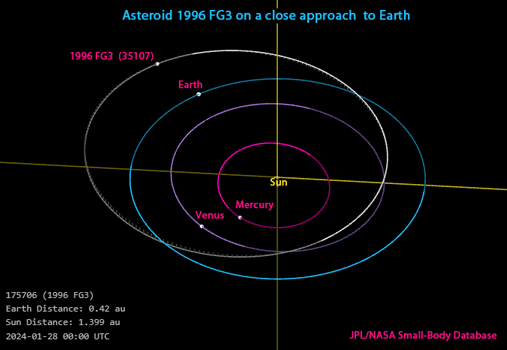
The Small body database viewer is quite robust. It has controls for turning on and off labels and orbits as well as many other features. The solar system can be rotated at varying rates with the touch of a button. The solar system can be oriented in many directions simply by controlling it with the mouse. So here is the solar system circumstances on the day in question. The yellow lines represent the ecliptic plane and the orbits are drawn so that the ascending and descending nodes can be recognized. When the lines are brighter and sharper, they are above the plane of the ecliptic. If they are fainter, they are below the ecliptic.
Here is a link to the database with 1996 FG3 already loaded in the orbit viewer at JPL
1997XF11 was discovered by Jim Scotti in the course of the Spacewatch program at the University of Arizona.
More powerful instruments and better observations are in place today that helps to keep the asteroid hunting enthusiasts from crying, "wolf!"
2008 HU4 - An article by Paul Gilster presents the case that this object might be artificial
Is it an asteroid or a piece of space junk, like a Saturn rocket? The next close approach of this NEA is 2016, to return again in 2026. This seems like a good opportunity to check it out to see if it is a sound candidate for the Asteroid Redirect Mission.
Orpheus 1982 HR - Asteroid Dreams 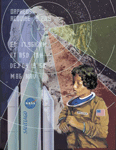
It seems as though I (Astra a.k.a. Dawn Jenkins) have spent my entire life dreaming of travel to the moon, the solar system, and the stars beyond. Perhaps inspired by the astronomers scanning the skies for those unknown terrors from space, those potentially dangerous asteroids, as a young adult I dreamed of a planetary defense that protected us from that menace from space.
Even though planetary defense seemed a necessary activity, I also realized that those distant neighbors could be the source of great riches, if only we could explore them in detail and discover which ones held those hidden treasures. In 2000, I was asked to present my own vision for the future of space exploration, by the editors of the newsletter at NASA Glenn Research Center. I worked in an area that was building an orbiting laboratory that is currently in use on the International Space Station but I dreamed of exploring the solar system. So I wrote about a mission to a nearby asteroid.
After careful research, I settled on the Apollo asteroid, 3361 Orpheus (1982 HR) an NEA that was discovered on April 24, 1982 by Carlos Torres at the Cerro El Roble Astronomical Station. This asteroid has quite an eccentric orbit that carries it across the orbits of the Earth and Mars at times approaching our sister planet Venus as well. From late 2013 to early 2014, Orpheus "terrorizes" the inner solar system. But it was the close passage of November 21, 2021 that I chose for Dione Wilder, my mission commander, to dream of that spaceflight. This trip is attractive because there is another close passage in June of 2022.
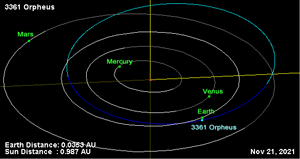 3361 Orpheus 1982 HR
3361 Orpheus 1982 HR
Discovery Date: April 24, 1982
You can read this story, Asteroid Dreams, in a different section at Astra's Star Gate.
Didymos, or 1996 GT, is a small asteroid (780 meters) that is also a binary system. The asteroid was discovered in 1996 under the Spacewatch survey at Kitt Peak observatory. Its small moon (160 meters)was discovered in 2003 using the radar observations from Goldstone. The moon was named "Dimorphos" and because of the binary nature of the system, it called, "Didymos", a Greek word for twin. Didymos is classified as potentially hazardous asteroid. It is considered to belong to the Apollo and Amor asteroid group.
Didymos is the target of the DART mission that will test the possibility of redirecting an asteroid by collision with a spacecraft. Didymos was the target of the proposed robotic Asteroid Impact & Deflection Assessment (AIDA) mission, a collaboration between ESA and NASA that was cancelled in 2016. Hera – named after the Greek goddess of marriage
Hermes was discovered on images taken at Heidelberg Observatory by Karl Reinmuth on October 28, 1937. Some observations were made in 1937, but as it grew further from Earth, it as lost to the telescopes of the day. It also has the designation 1937 UB but Reinmuth named it "Hermes".
Hermes was recovered on October 15, 2003 by Brian A. Skiff working on the LONEOS project. Because of its eccentric orbit, Hermes is an Earth crossing asteroid that also crosses the orbits of Mars and Venus.
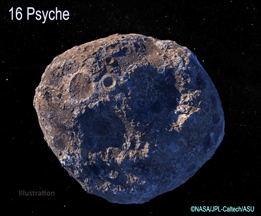 16 Psyche is a main belt asteroid orbiting between Mars and Jupiter. Because of this, it is really not an NEA. Psyche gets the 16 designation because it was the 16th asteroid that was discovered by earth-based observers. Psyche is a large asteroid, about 226 km in diameter and is an M-type (metallic) asteroid. Because of its high iron and nickel content (it is similar to Earth’s core), it may be that Psyche is the exposed core of an ancient planet that lost its rocky outer layers due to violent collisions billions of years ago. Psyche orbits the sun every 1,830 days (5.01 years) and it's distance from the Sun varies from 2.53 AU to 3.31 AU.
16 Psyche is a main belt asteroid orbiting between Mars and Jupiter. Because of this, it is really not an NEA. Psyche gets the 16 designation because it was the 16th asteroid that was discovered by earth-based observers. Psyche is a large asteroid, about 226 km in diameter and is an M-type (metallic) asteroid. Because of its high iron and nickel content (it is similar to Earth’s core), it may be that Psyche is the exposed core of an ancient planet that lost its rocky outer layers due to violent collisions billions of years ago. Psyche orbits the sun every 1,830 days (5.01 years) and it's distance from the Sun varies from 2.53 AU to 3.31 AU.
Because of its high metal content, this asteroid could be a very valuable resource. Some people believe that the first asteroid miners on Psyche could become very rich if precious metals mined on the asteroid could be returned to Earth. There have been many stories in the media proclaiming this asteroid to be of a very high value as a resource, as much as $700 quintillion. First, it is unknown exactly what metals Psyche is made of and it is between the orbits of Jupiter and Mars, so it is not very accessible. However, it could prove to be a good resource when humans finally make it out past the Earth's neighborhood of the solar system.
NASA is planning an exploration mission to Psyche - click for an article on the asteroid mission page
=> Use this link to return to Asteroid Information
This page was updated by Dawn Jenkins, June 27, 2022.